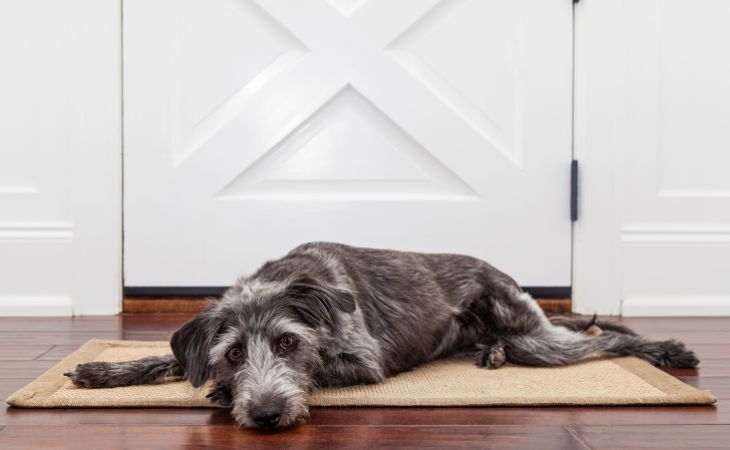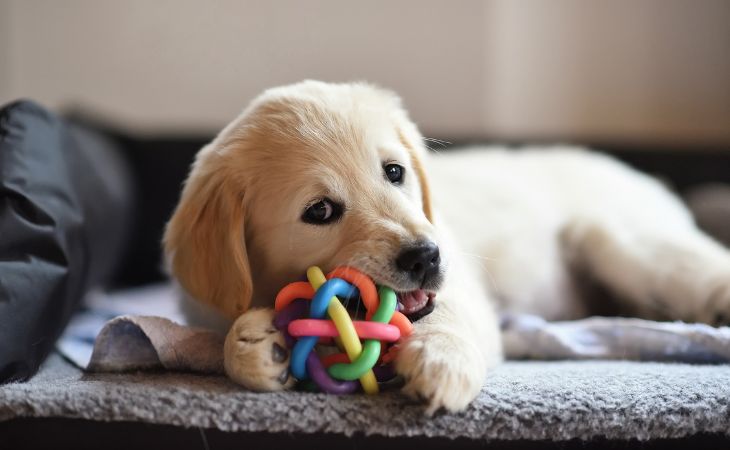Signs of abandonment anxiety in dogs
The signs associated with abandonment anxiety in dogs vary across different levels. At its mildest level, a dog may refuse food when no people are present around them. Conversely, at its most severe level, a dog might resort to destructive behavior such as destroying doors or windows in order to search for their family outside the house. Other common signs are:
- Making constant noises, drooling and pooping or peeing in the house when alone.
- Frequently licking a specific area on the body (resulting from a self-inflicted wound by the dog).
- Following people around the house and moving from room to room, not wanting to ever be alone.
One thing that is good to know is that dogs that display fear towards other things, such as thunderstorms, have a higher likelihood of developing separation anxiety. This is also true for breeds that have a tendency to be more attached to humans, like herding dogs.

How can we assist a dog with abandonment anxiety?
It is advised to address this issue as early as possible by taking the dog to the veterinarian and ruling out any medical conditions that may be mistaken for signs of abandonment anxiety. If it is indeed separation anxiety, there are several ways you can help your dog become accustomed to being left alone. However, it's important to note that this process takes time and patience. If you find that your training efforts are exacerbating their anxiety, it may be best to step back and change your approach or even seek assistance from a professional dog trainer.
It is also important to note, that there IS one fix for abandonment anxiety in dogs that almost always works, and that's getting a second dog. A second dog, while adding to expense, actually makes less work for you, as they entertain and keep the other dog company, making both happy campers. Of course, this isn't feasible for many households, and that is why we have the following 5 tips for you:
1. Utilize positive reinforcement techniques
Devote some time each day to train your dog, focusing on the idea that he should anticipate receiving a reward after calming down, rather than eagerly awaiting your return. When you come back from work or running errands, avoid making it an extravagant and joyous occasion for your furry friend. Simply remove your shoes, have a drink of water, and allow your dog some time to unwind. Once he has settled down, you can reward him with attention, taking him for a walk outside or engaging in playtime with his favorite toy.
The objective is to teach the dog that his excitement should not stem from your arrival but rather the reward that follows once he has calmed down. This will help shift his focus away from fixating on when you leave or anxiously waiting for you to come back towards finding solace within himself.
2. Crate training
Crate training can be highly beneficial in alleviating separation anxiety in dogs. Ensuring that the crate is comfortable and tranquil is crucial; never coerce the dog into entering it as a form of punishment. Instead, aim for him to perceive the crate as a secure haven where he feels safe and protected. In order to reinforce this sensation, provide your canine companion with a treat that cannot be devoured in one gulp while inside the enclosure. For example, try using a slow-feeding toy filled with peanut butter.
Another approach is to allow your dog to consume their meals within the confines of the cage as a form of positive reinforcement. Over time, your furry friend will associate the cage with relaxation, sleep, and nourishment. This will enable them to seek solace in it when you are not at home and alleviate any anxiety they may experience.

3. Training dogs for independence
You can train your dog for independence by gradually introducing short periods of separation during your interactions. For example, leave them in the bedroom while you go into the bathroom and close the door. Although they can still hear you from outside, it is important for them to understand that it is acceptable for them to stay outside the room where you are located. As time progresses, increase these intervals of separation between yourself and your dog while carrying out various activities around the house, such as taking a shower or preparing dinner.
By implementing these strategies consistently over time, you can help foster a sense of comfort and independence in your furry companion even when you are not physically present by their side. Once you have been practicing this for a period of time, you can begin training by taking short trips outside the house while leaving your dog at home. For example, you can throw out the garbage, collect mail from the post office, or tend to the garden while your dog remains at home in his crate with a slow-feeding toy. During these trips, it is important that your dog cannot see or hear you, as this may be frightening for him. However, it is an important step in helping him become more comfortable being alone.
As you progress in the training process, you can take it a step further by going on short drives with your car so that your dog becomes familiar with the sound of your car entering and exiting the parking lot. This will help him associate that sound with your departure and gradually reduce his anxiety. It is normal for dogs to still feel anxious before being left alone because they recognize the routine and anticipate their owner's departure. To address this issue, it is recommended to vary your daily routine during the first phase of training. For example, if you typically shower in the morning before leaving for work or errands, try showering at night instead. Additionally, during these initial stages of training, consider going outside briefly to put items in your car before returning inside to continue organizing or preparing for departure. By doing so, it will keep your dog guessing when exactly you will leave.
Remember that patience and consistency are key throughout this process, as every dog's progress may vary. With time and practice using these techniques when leaving them alone, gradually longer durations should become easier for both pet parent and fur baby alike!
4. Make sure they are entertained
The more intelligent a dog, the faster it will be bored. When you're not around, your dog may become bored at home and miss the interaction they have with you when you are present. To address this issue, there are several actions you can take based on what proves to be more effective:
- Prior to heading off to work, take your dog for a lengthy walk in the morning so that they can enjoy quality time with you.
- Engage in playtime with your furry friend for about 20-30 minutes before departing from the house. This will help tire them out a bit.
- Leave behind an interactive toy that dispenses food or treats to keep your pet distracted and entertained during your absence.
- Switch on a radio or television program that features human voices for the company of the canine companion (preferably entertainment shows rather than action movies).

5. Nutritional supplements and medications
While you may oppose the idea of administering drugs to your dog, it is worth considering that they can serve as a temporary solution to assist in training. If, despite your best efforts, your dog continues to display intense anxiety and destructive behavior when you leave the house, seeking advice from a veterinarian regarding nutritional supplements or sedatives is strongly advised.
Taking into account factors such as the age of your dog, medical history, and severity of anxiety symptoms, the vet will prescribe appropriate supplements and medications to address the issue at hand. It is important to understand that some treatments may take several weeks before any noticeable improvement is observed.
In conclusion...
Taking on the responsibility of adopting a dog is no small feat and comes with its fair share of challenges that cannot be bypassed. If your furry companion is grappling with separation anxiety due to past abandonment, it is crucial that you make every effort to assist them in overcoming this hurdle. It's possible that you may also feel anxious about leaving your dog alone for extended periods, but by gradually increasing the time apart, you can both work towards establishing a more normal routine. Patience and persistence are key when dealing with separation anxiety in dogs, and eventually, positive changes will become evident. Remember that throughout this process, seeking guidance from a veterinarian or enlisting the aid of a professional dog trainer can provide valuable support. Rest assured knowing that this issue is one that can be addressed and resolved successfully through dedication and care.



